OUR SERVICES
Semed Living Care Hospital

SEMED Living Care Hospital, a comprehensive provider of occupational health check-up services in accordance with legal requirements, offers services with a team of knowledgeable and specialized medical personnel, utilizing high-quality standard equipment and advanced information technology systems to ensure that health check-up services are fast and efficient. Our goal is to ensure customer satisfaction and maximize benefits.

Benefits of Annual Health Check-ups
Nowadays, health risks are present all around us due to various factors such as environmental pollution, chemical contaminants, stress, unhealthy behaviors, genetics, and aging. All these can lead to illnesses and serious diseases. Annual health check-ups are therefore crucial as they help us understand our body’s condition, detect abnormalities or risks of serious diseases before symptoms appear, or before the disease progresses to a stage that is difficult to treat.
Preparation for Annual Health Check-up
1.Get Enough Rest
- Ensure you get at least 6-8 hours of sleep before your health check-up, as it affects blood pressure and heart rate.
2.Avoid Food and Beverages
- For blood sugar tests, refrain from eating and drinking for at least 8 hours (sipping water is allowed).
- For blood lipid tests, refrain from eating and drinking for at least 12 hours (sipping water is allowed).
- Avoid alcoholic beverages for at least 24 hours before the health check-up.
- Avoid energy drinks, tea, coffee, and smoking before the health check-up, as they can affect blood pressure readings.
3.Prepare Health Information
- Inform the doctor if you have any illnesses, exposure to hazardous chemicals, abnormal body symptoms, chronic diseases, or other health histories. Bring any previous health check-up results or medical records for the doctor’s reference.
4.Notify Staff if Pregnant
- If you are pregnant or suspect you might be, inform the staff before the health check-up. Some tests, such as chest X-rays, muscle function tests, or lung function tests, may affect pregnancy.
5.Wear Comfortable Clothing
- Wear comfortable clothing that is not too tight. For blood pressure measurement or blood tests, wear clothes that allow easy sleeve rolling. For chest X-rays, women should avoid wearing metal-framed bras to prevent interference with the imaging.
Steps for Annual Health Check-up
1.Registration
- Visit the information desk to inform them of the health check-up program you are interested in or to receive recommendations on programs and service fees from the staff. Then, proceed with the health check-up registration by using your identification card and providing your full name at the registration point.
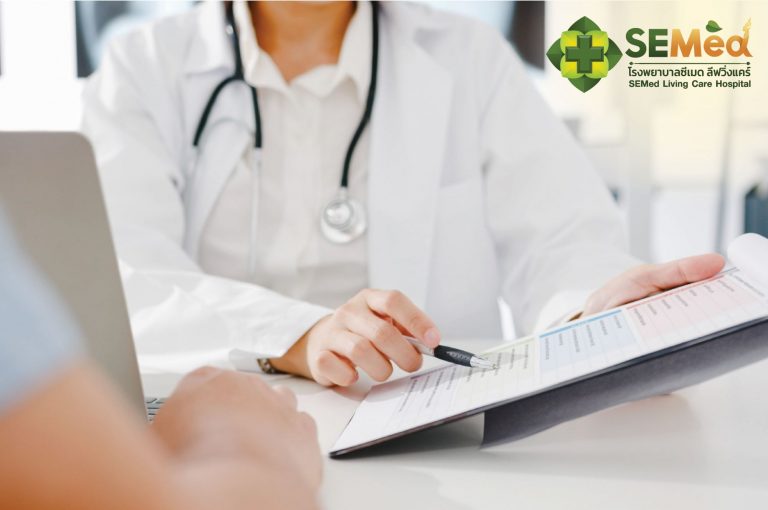
2.Weight-Height Measurement
Weight and height measurements are used to calculate the Body Mass Index (BMI, unit: kg/m²) to assess whether your weight and height are within the normal range, and to evaluate the risk of various diseases. Individuals who are overweight or obese are at higher risk for health issues and diseases such as high blood pressure, high cholesterol, diabetes, heart disease, stroke, gallbladder disease, osteoarthritis, sleep apnea or breathing problems, and various types of cancer. These conditions can also limit the ability to perform high-risk jobs, such as working in confined spaces or at heights.
For individuals with a BMI below the normal range, there may be a reduced efficiency of the body’s functioning or an increased susceptibility to infections. Therefore, it is important to maintain a normal weight by consuming a balanced diet with all five food groups in adequate amounts, getting sufficient rest (at least 6-8 hours of sleep), and exercising regularly (at least 30-50 minutes per day, 3-5 days a week). Individuals with chronic diseases should consult a doctor before starting any exercise program.
3.Medical History and Blood Pressure Measurement
- Measuring blood pressure is essential to assess the risk of hypertension, which can lead to various conditions such as stroke, heart disease, heart attack, kidney failure, aortic aneurysm, and paralysis.
Instructions for Blood Pressure Measurement:
- Sit comfortably and relax. Do not tense your arm or talk while your blood pressure is being measured.
- Provide accurate information to the staff for better interpretation of the health check-up results and the doctor’s diagnosis.
- If you feel short of breath, rest for 5-10 minutes before measuring your blood pressure.
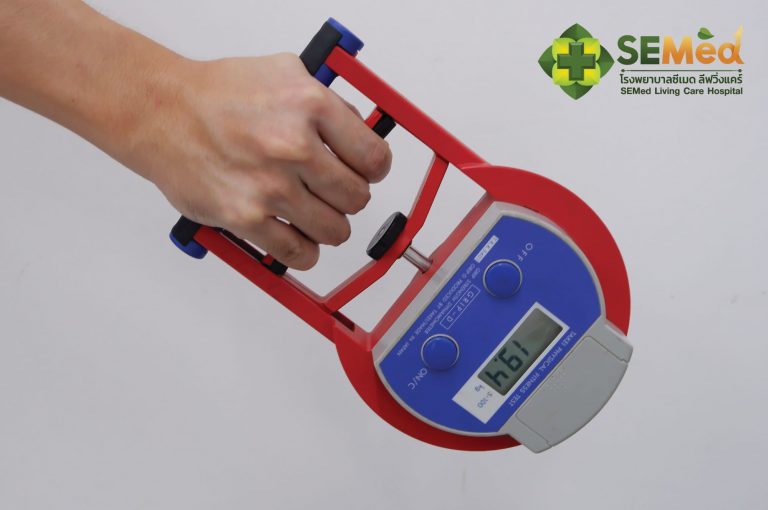
4.Muscle Strength Test
- This test assesses the strength of muscles used for physical work. It includes testing the grip strength muscle, leg strength muscle, and back strength muscle.
Guidelines for Muscle Strength Test:
- It is recommended to perform the muscle strength test before a blood draw. If you have already had a blood draw, proceed with other check-up points before returning for the muscle strength test to prevent bruising from subcutaneous bleeding.
Contraindications for Muscle Strength Test:
- Do not perform the test if you are pregnant or suspect you might be, if you have muscle injuries in the areas to be tested (e.g., arm, leg, and back muscles), or if you are within three months post-surgery.
5.Blood Collection
- Blood tests are laboratory diagnostic tests because many illnesses cannot be diagnosed immediately. Blood tests help detect various abnormalities in the body, such as complete blood count, anemia or thalassemia, cholesterol levels, blood sugar levels, liver, kidney, and thyroid function.
Guidelines for Blood Collection:
- It is recommended to use your non-dominant arm for blood collection.
- After the blood draw, press the puncture site for 1-2 minutes to help stop the bleeding. Avoid folding your arm, massaging, or using the punctured arm forcefully, as this may cause red blood cells to leak from the blood vessels at the puncture site, leading to bruising.
- If you are afraid of needles or feel faint and dizzy, inform the staff before the blood draw.
6.Physical Examination by a Doctor
- A physical examination by a doctor assesses your current health status to detect any underlying abnormalities. If you have symptoms of illness, exposure to hazardous chemicals, abnormal body symptoms, chronic diseases, or other health histories, you should inform the doctor. If you have any previous health check-up results or medical reports, please bring them along for the doctor’s diagnosis.
7.Lung Function Test
- This test measures lung capacity by evaluating the volume of air inhaled and exhaled to assess any restrictive or obstructive lung conditions. Lung function tests can indicate a decline in lung performance before symptoms appear.
Guidelines for Lung Function Test:
- Avoid eating a large meal at least 1 hour before the test.
- If you use bronchodilators, stop using them before the test.
Contraindications for Lung Function Test:
- Do not perform the test if you are pregnant or suspect you might be, if you experience dizziness, if you are within three months post-abdominal surgery, if you have respiratory infections, or if you have high blood pressure.Avoid exercising before the test.
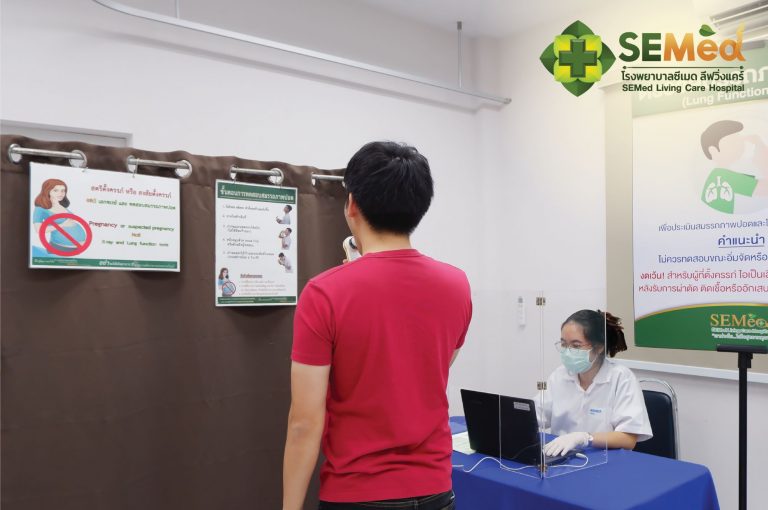
8.Occupational Vision Test
- This test measures the ability of both eyes to see together, both at near and far distances. It evaluates visual acuity, depth perception, color differentiation, and visual field, particularly for those working with driving or moving objects, to assess whether their vision is suitable for their job tasks.
Guidelines for Occupational Vision Test:
- Inform the staff about your job description and department so they can choose the appropriate test according to your job characteristics.
- Respond to the staff’s questions based on the images you see in the testing device.
- On the day of the health check-up, ensure your eyes are in a good condition for testing, without issues like eye pain, redness, or fatigue from work.
- If you use eyeglasses or contact lenses for work, bring them for the vision test on the day of the health check-up.
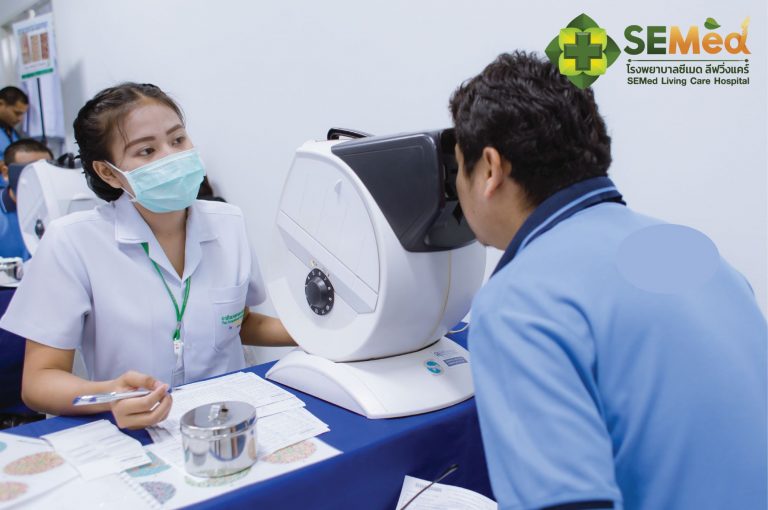
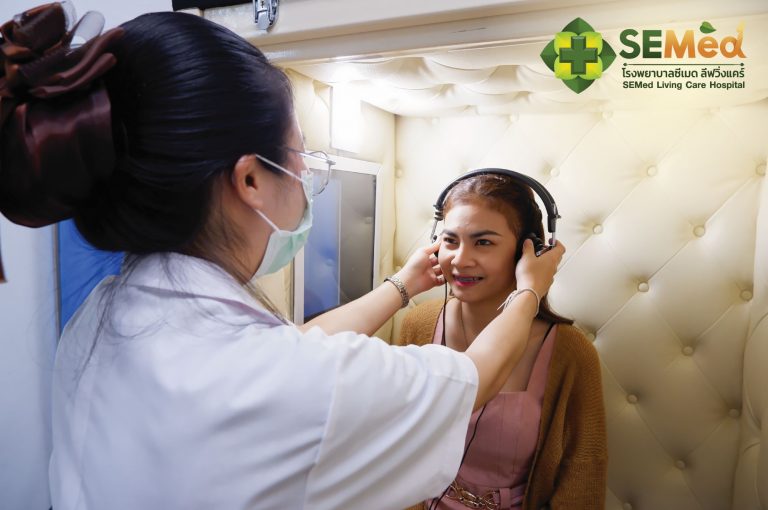
9.Screening Audiometry
- Hearing performance tests are conducted for individuals exposed to loud noise at work to screen for potential noise-induced hearing loss. This test covers a frequency range of 500-8000 Hz, from low frequencies such as conversational speech to high frequencies such as machinery noise. It helps identify individuals with hearing impairment who need further diagnosis and treatment by a specialist and ensures they receive proper care and protection to prevent further hearing deterioration.
Guidelines for Hearing Performance Test
- Avoid loud noises for at least 12 hours before the test. If avoidance is not possible, wear hearing protection or leave the noisy area for at least 15 minutes before the test.
- Inform the staff of any health issues related to hearing.
- If you feel unwell, have a cold, or experience ear congestion, inform the staff as these conditions may affect your hearing.
- Wear the headphones snugly. The staff will play a series of sounds that gradually decrease in volume. Press the test button each time you hear a sound, even if it is very faint.
10. Chest X-ray
The chest X-ray assesses the physical characteristics of organs in the chest area, such as the lungs, heart size, spine, and diaphragm, and can detect early-stage pulmonary tuberculosis.
If abnormalities are found:
- White spots on the lungs: Consult a specialist (Pulmonologist) for further diagnosis.
- Enlarged heart: Often seen in individuals with high blood pressure or blocked arteries, causing the heart to work harder. If significantly enlarged, consult a specialist (Cardiologist) for further diagnosis. (Note: Incomplete inhalation during the test may cause the diaphragm and ribs to appear smaller, making the heart seem larger than normal.)
- Spinal curvature: Can occur at any age but is more common during adolescent growth spurts (more in females than males) or in adults with degenerative changes. If the curvature is mild and painless, medical consultation is not necessary. For severe curvature, consult a specialist (Orthopedic Surgeon).
- Old lesions or calcified spots: These are remnants of previous inflammation that the body has repaired and pose no health risk.

Guidelines for Chest X-ray
- Avoid wearing clothing with any metal components or underwire bras for women.
- Remove all items from your shirt pockets or the chest area to prevent metal objects from obscuring any potential abnormalities.
Contraindications for Chest X-ray
- Do not undergo an X-ray if you are pregnant or suspect you might be pregnant.
11.Electrocardiogram (EKG)
An electrocardiogram is a preliminary heart assessment test used to screen for heart disease risks and to monitor or further diagnose various conditions, such as heart rhythm abnormalities, electrical conduction issues, enlarged heart, myocardial infarction, and ischemic heart disease. The EKG should be performed on individuals with risk factors for heart disease, such as high cholesterol, smoking, diabetes, and those working in confined spaces or at heights. If abnormalities are detected, consultation with a cardiologist is recommended for further evaluation.
Guidelines for Electrocardiogram
- Remove all jewelry and metal objects, and turn off all communication devices.
- During the test, lie down comfortably with your arms at your sides and remain still.
- Avoid energy drinks, tea, coffee, and smoking before the test.

12.Urine Collection
Urine samples are used to assess kidney disease, diabetes, urinary tract infections, urinary tract injuries, urine pH, color, and sediment, which may indicate stones or uric acid crystals. They are also used to check for the accumulation of chemicals in the body for those working with hazardous chemicals. If abnormalities are found, further diagnosis by a doctor may be necessary.
Guidelines for Urine Collection
- Clean the external urethral area with clean water and dry it.
- Discard the initial stream of urine, then collect a midstream sample to a volume of at least 20 ml or two-thirds of the container.
- Submit the urine sample at the designated collection point.
13.Stool Examination Collection
Stool samples are used to detect parasites in the intestines or other organs connected to the intestines. Proper collection and submission methods are crucial for accurate analysis. Due to the uneven distribution of parasite eggs in stool, samples should be collected from multiple areas within the same sample. Repeated testing of the same sample increases the likelihood of detecting parasites. Additionally, the appearance of parasite eggs can vary from day to day. Stool examinations assess digestive system functions, including nutrient absorption and other diseases. The doctor will examine the following:
Characteristics:
- Consistency (liquid, solid, presence of mucus or blood) Color:
- Stool color is influenced by the food consumed, bile released from the gallbladder, and any blood in the digestive tract. White stool may indicate bile duct obstruction. Black stool may indicate upper gastrointestinal bleeding, while red streaks may suggest lower intestinal bleeding.
Microscopic Examination:
- Detect parasite eggs using a microscope. Occult Blood Test:
- Sometimes, small amounts of blood are not visible to the naked eye, so chemical reactions are used to detect blood in the stool. A positive result indicates bleeding in the gastrointestinal tract, potentially caused by ulcers, gastrointestinal cancer, or hemorrhoids.
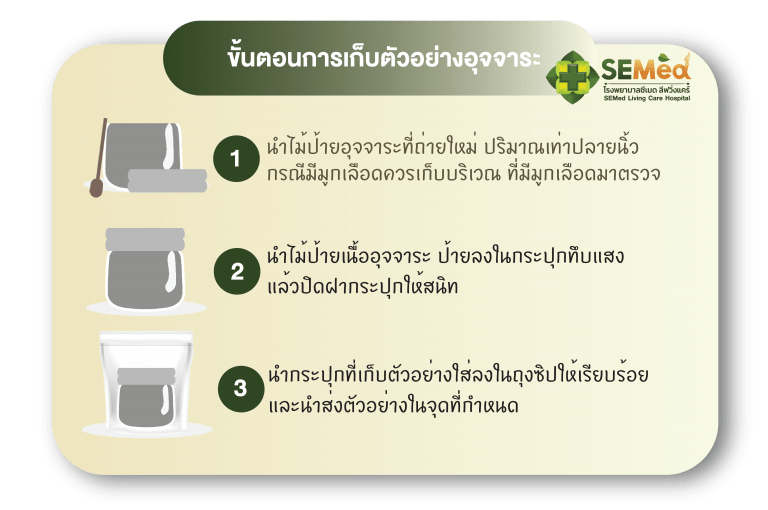
Guidelines for Stool Sample Collection
- Use a stick to collect a fresh stool sample about the size of a fingertip. If there is mucus or blood, collect the sample from that area.
- Place the stool sample into an opaque container and securely close the lid.
- Place the opaque container in a zip-lock bag and deliver the sample to the designated collection point.
14.Stool Culture Collection
Stool culture samples are used to detect pathogens in the gastrointestinal system, such as Vibrio cholerae (cholera), Salmonella typhi (typhoid), Salmonella paratyphi (paratyphoid), and Shigella spp. (dysentery).
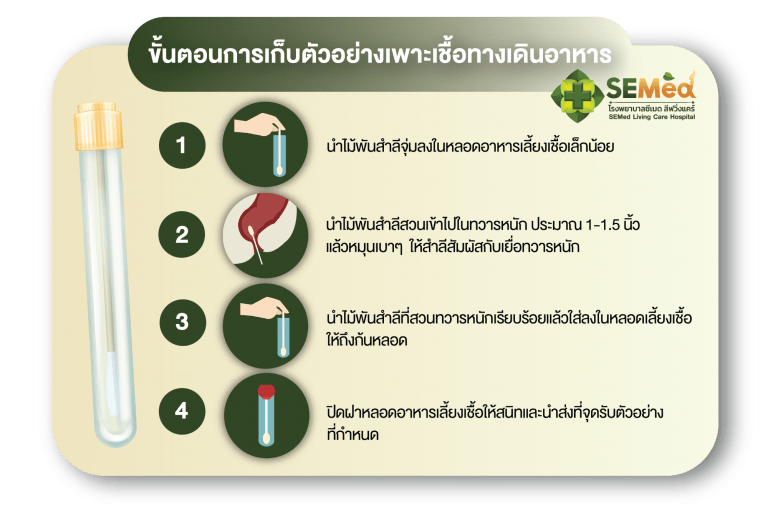
Guidelines for Stool Culture Collection
- Dip a cotton swab slightly into the culture medium tube.
- Insert the cotton swab into the rectum about 1-1.5 inches and gently rotate to ensure contact with the rectal mucosa.
- Place the swab back into the culture medium tube, ensuring it reaches the bottom of the tube.
- Securely close the lid of the culture medium tube and deliver the sample to the designated collection point.
TEL : 081-358-6493 (MR.AON), 086-368-5317 (MR.ICE)
Email : [email protected]
Line : @semed
Facebook : SEMed living care hospital




